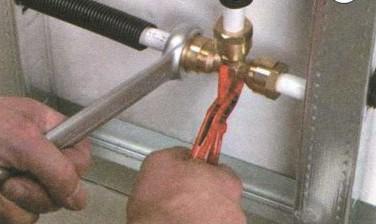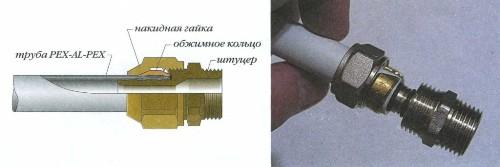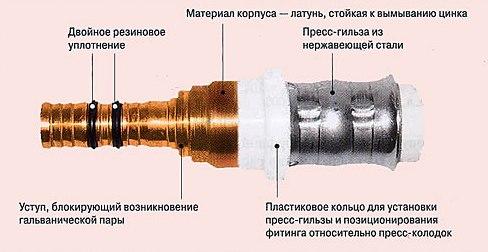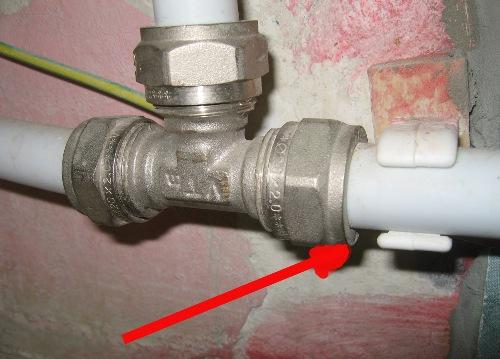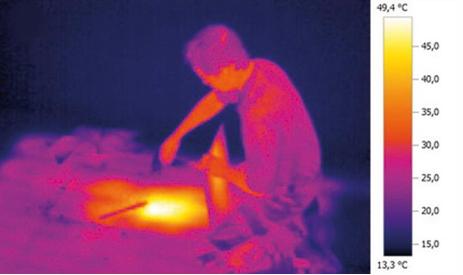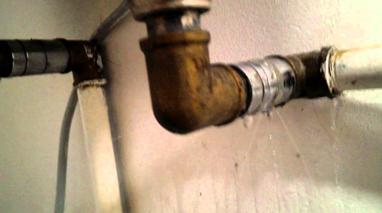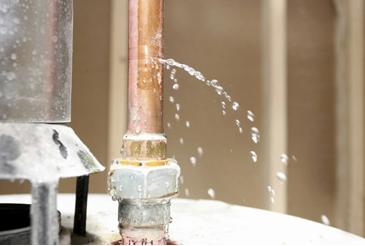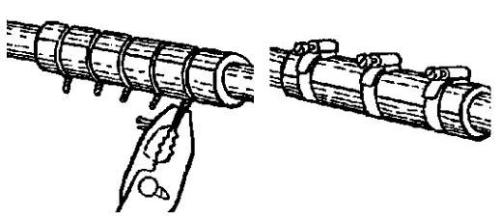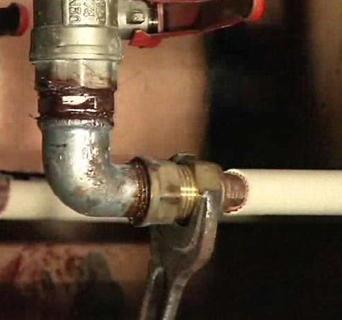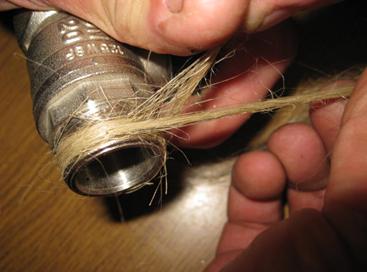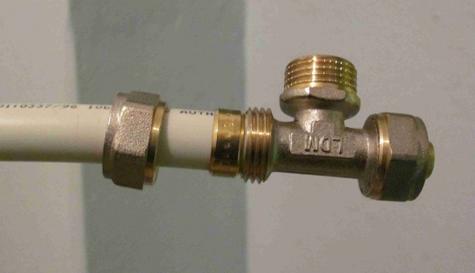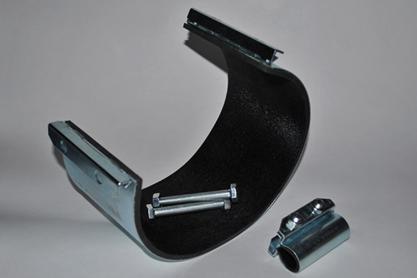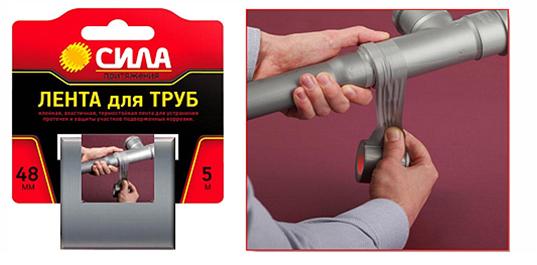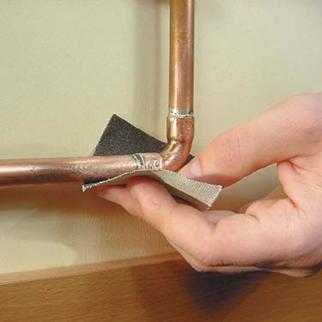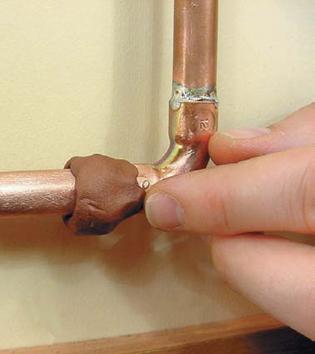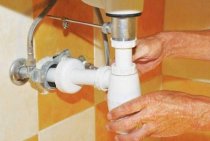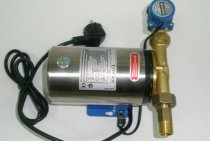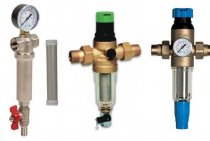Liquidation of leaks near fittings
As a rule, leaks in metal-plastic pipes appear due to problems with connecting devices, namely fittings. To eliminate water leakage, sometimes it is enough to tighten the nut more tightly, since it is common for compression fittings to weaken the connection strength over time (frequency - 1 time in 2-3 years).
Nuts need to be tightened periodically.
If after that the water continues to leak, you need to perform a thorough revision of the system. To do this, drain the water from the pipeline and follow the instructions:
- check the sealing rubber ring inserted between the fitting and the fitting body for damage;
- evaluate the degree of wear of the rubber gaskets on the fitting;
- inspect how the cut of the pipe is made evenly.
The layout of the ferrule in the fitting
After fixing the problem, assemble the pipeline by treating the joints with silicone grease and wrapping the threads with sealing material (for example, FUM tape).
Elimination of leaks in pipelines mounted using press fittings
When using press fittings made of brass for the assembly of metal-plastic pipelines, an adjustable wrench is required. The installation of this connection involves tightening the nuts with little effort up to a certain point.
Sometimes the nuts are tightened too much, which leads to defects in the soft ring located inside the press fitting, and, as a result, to leakage.
If this is exactly what happened to you, do-it-yourself repair of metal-plastic pipes is done as follows:
Press fitting diagram
- dismantle the leaking connection: unscrew the cap nut, remove the end of the pipe from the fitting;
- remove the old soft ring from the fitting with a hacksaw, process the pipe cut with a fine-grained grinding mesh (you can take a regular wire sponge), put a new ring on the pipe;
- reassemble the connection; tighten the cap nut located on the body of the connecting device with a wrench, making one full turn;
- check the waterproofing of the joint - if the leak is not eliminated, tighten the nut with a wrench another 1/4 turn.
Causes and types of problems
The metal-plastic pipe is made of aluminum and protected by several layers of polyethylene inside and out, welds are made by laser. Such a structure guarantees the strength of the product and resistance to corrosion. Therefore, if you have metal-plastic pipes flowing, this may be due to the following problems:
- when laying pipes, the installation technology was violated (for example, the bending radius was exceeded);
- during operation, a serious mechanical impact occurred, resulting in a violation of the integrity of the pipes;
- water seeps from poorly made joints.
Most common leak site
It is possible to prevent a possible failure of the pipeline even at the time of its installation. When laying metal-plastic pipes, bends are carried out using springs specially designed for this. The maximum bending angle is 45, otherwise the pipe may burst during operation.
The main types of pipe leaks
If moisture appears on the pipes, water droplets form at the junctions, or pressure drops sharply in the hidden pipeline system, then these are the first signs of a leak.
Finding a leak in metal-plastic pipes or any other types with an open passage of the pipeline is not a problem. And what to do if a leak has formed in a closed pipeline? You can find a leak using a special device - a thermal imager.In the place of accumulation of moisture, the thermal conductivity of the finishing material increases, which immediately catches the device.
Leak detection with special equipment
So, a leak in a polypropylene pipe (plastic or metal-plastic pipe) can be located:
at the junction of pipes. The reasons may be an incorrect connection of pipes, a defective fitting, an incorrect temperature regime selected during the formation of a joint, an incorrectly selected adhesive composition, and so on;
Leakage at pipe connection
on a flat section of pipeline. Leaks can be caused by water hammer caused by pressure drop in pipes, natural wear or mechanical damage.
Breakthrough on a flat section of pipe
The way to eliminate the leak depends on the place where the leak has formed.
Repair of damaged metal-plastic pipes
If the metal-plastic pipe itself fails, for example, if it breaks, it is necessary to immediately replace the damaged part of the pipeline with a new one. Although if this is not possible, there are measures to temporarily eliminate the leak.
Damaged part of the pipe
Most often in this case, a bandage is used. This is a very reliable and long-term method of repairing small cracks. In practice, pipes with bandages installed on them can be used for a long period, up to the violation of integrity in another place.
How to repair a metal-plastic pipe using a bandage is described below:
- prepare a bandage - you can buy it in a store or make it yourself (metal clamps with the desired diameter are suitable for this);
- measure the required length of the bandage, providing allowances of 2 cm or more on both sides of the fault;
- wrap the damage on the pipe with a piece of rubber 2-5 mm thick, put the bandage itself on top, fasten it firmly.
The bandage is indispensable for repairing not only cracks and fistulas in metal-plastic pipes, but also some other small damages. It is impossible with its help to “patch” only long, extensive cracks.
Scheme for creating a bandage
You can understand whether it is expedient to repair a metal-plastic pipe, or is it still better to replace it, by assessing the size of the damage. If the damage (or fistula) is small, try cold welding. For this:
- drain the water from the pipeline, free from pressure;
- dry the place of the gap, process it with sandpaper;
- cover the fistula with a cold welding solution.
The final drying of welding occurs in about a day, after which the pipeline is ready for operation. However, keep in mind that cold welding is not always suitable for repairs: it is destructively affected by high internal pressure in the system and temperature changes.
I would especially like to note that metal-plastic pipelines, with qualified installation using high-quality materials and with periodic measures to prevent leaks, serve for many years without bringing problems to their owners.
Repair of pipe joints
First, let's look at how to fix a plastic pipe leak at the junction. The algorithm of actions should be as follows:
- First of all, it is necessary to block the flow of water into the pipe. If a plastic pipe is leaking, which is part of the wiring in the apartment, then it is enough to turn off the tap located next to the water meters. If a leak has formed on a common house riser, then it is necessary to turn off the water in the basement. To do this, you can call the plumber on duty from the organization servicing the house or use the key stored by the person responsible for the house;
- if the fitting is secured with a threaded connection, then you can simply try to tighten the thread with a wrench or adjustable wrench;
Fixing the fitting with a wrench
- if tightening the connection does not help, then it is necessary to replace the insulating layer. Most often, linen thread or FUM tape is used for insulation;
Joint insulation with linen thread
- if after carrying out the described operations it was not possible to eliminate the leakage of the fitting, then a complete replacement of the connecting element will be required.
Fitting replacement
If the connection of metal-plastic pipes is leaking and the fitting needs to be replaced, then it is necessary to prepare:
- scissors for cutting pipes;
- threading tools;
- sealant;
- wrench;
- new fitting.
The replacement process takes place as follows:
- the old connecting element is carefully removed with scissors;
- threads are cut in sections of the pipe;
Arrangement of a thread on a pipe
The size of the thread to be cut must correspond to the same parameter available on the connecting element.
- the joints are sealed with the selected insulating material;
- a new fitting is fixed.
Fixing a new connector
Instead of threaded fittings, compression fittings or elements installed by welding can be used, but in this case the resulting joint will be one-piece.
Causes of accidents in non-pressure pipelines made of polypropylene
The pressure in non-pressure systems is equal to atmospheric. The capacity of such lines is calculated in advance. In addition, the installation of joints in non-pressure systems is carried out using socket technology, with sealing of the contact point with a conventional rubber sealant. That is, it is not worth fearing exorbitant internal pressure or errors in the assembly of the pipeline, in this case.
As a result, only a “third force”, malicious or accidental, can damage a polypropylene pipe in such a system.
Moreover, such an impact can look like an attempt to dump a highly active chemical substance into the system, and like the operation of the system with a deliberate violation of the temperature regime, and like a trivial mechanical damage.
However, theoretically, another reason for such accidents may be factory defects unnoticed in the technical control departments of the polypropylene pipe manufacturer. However, such defects in polypropylene pipelines are not common. The production process of such products is controlled quite carefully. Therefore, such a "reason" can be neglected.
Causes of an accident in pressure pipelines made of polypropylene
Building codes that regulate the laying of polypropylene pipelines allow the use of such structures not only in non-pressure lines, but also in pressure systems.
After all, the pressure pipeline is mounted on a sufficiently strong welded joint that does not forgive technological errors. Misalignment of the pipe in the coupling, errors in the soldering process, breakdowns of the welding machine - this is just a short list of the causes of accidents at the joints. Moreover, most of the accidents of pressure pipelines are provoked precisely by "docking" reasons. Therefore, we will begin the analysis of methods for eliminating leaks and breakthroughs in pipes by studying ways to deal with poor-quality joints.
Repair of a flat section of the pipeline
If a metal-plastic pipe (plastic, polypropylene, and so on) leaks on a flat area, then the leak can be eliminated in one of the following ways:
use a clamp. This is a special device equipped with a rubber gasket that allows you to achieve a tight connection. The main advantage of the clamp is the speed of eliminating leakage, and the main disadvantage is the fragility of the resulting connection;
Device for temporary repair of pipe leaks
use adhesive tape. A special tape is a cheaper analogue of a clamping collar. Applying the tape is pretty easy. It is necessary to wrap the place of leakage in several layers.The resulting connection will also be very short-lived;
Quick Leak Tape
- cold welding;
- adhesive bandage.
Application of cold welding
Mixtures for cold welding help to quickly and efficiently eliminate pipe leaks in the shortest possible time. To eliminate the leak, you must:
- block the flow of water into the pipeline;
- carefully clean the leak and completely dry the remaining water;
Pipe preparation for cold welding
- cut off a small piece of a special composition and knead with your fingers until a homogeneous mixture is obtained;
Kneading the composition until smooth
- apply the mixture to the crack in the pipe in an even layer and allow the material to be used to dry completely. On average, it takes 3-4 hours to harden.
Alignment of the composition on the pipe
It is required to perform the work as quickly as possible, since in contact with air the composition is polymerized in a short time.
The technology of using cold welding in various situations is presented in the video.
How to make an adhesive bandage
To make a bandage you will need:
- fiberglass. The dimensions of the fabric depend on the dimensions of the pipe. The optimal piece is considered to be a piece of fabric in width 2–3 times the diameter of the pipe, and in length, allowing the pipe to be wrapped 5–6 times;
- two-component glue;
- solvent.
You can make an adhesive bandage according to the following scheme:
- the pipe is cleaned of contaminants with a solvent, acetone or other similar compounds;
- fiberglass is impregnated with glue and wound in several layers on the damaged section of the pipe;
- complete drying of the resulting compound is expected.
Repairing leaks with an adhesive bandage
When eliminating a pipe leak by any of the above methods, it is necessary to strictly observe the safety precautions for working with pipes and additional materials.
